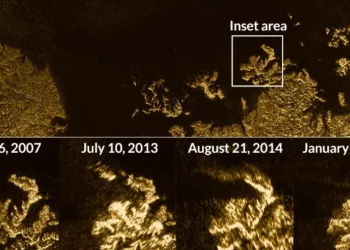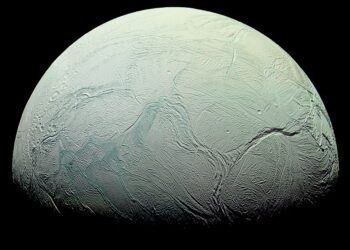NASA is preparing for a historical approach to Enceladus, plunging its Cassini spacecraft deep through the icy spray coming from the ocean on Enceladus.
An Ocean and Geysers on Enceladus

After years and years of observations, deductions and scientific reasoning, NASA can now say with almost certainty that there is an ocean of liquid water on Enceladus, hidden beneath its frozen surface – which makes it a very interesting target for detecting alien life.
Enceladus is the sixth-largest moon of Saturn, measuring only 500 km in diameter. It’s covered in fresh, clean ice that reflects most of the sun waves that reach it, but it has long been believed that Saturn’s tidal forces cause a shear stress on Enceladus, which in turn causes friction and generates enough heat for water to remain liquid beneath the surface. In 2005, the Cassini spacecraft started multiple close flybys of Enceladus, revealing its surface and environment in greater detail. Among its most interesting findings, Cassini reported a water-rich plume venting from the south polar region of Enceladus; by now, over 100 geysers have been identified, spewing not only liquid water, but also volatiles and even solid material, such as salt (sodium chloride). This seems to indicate that Enceladus not only has a liquid ocean of water, but also hydrothermal activity – which also rises the chances of emerging life.
These geyser observations, along with the finding of escaping internal heat and very few (if any) impact craters in the south polar region, show that Enceladus is geologically active today; you can see tectonic features on its surface, most notably the above described “water volcanism“. There are also relatively crater-free regions filled with numerous small ridges and scarps, as well as fissures, plains, corrugated terrain and other crustal deformations.

Flying by
It’s not the first time Cassini flew by Enceladus, but it’s the first time it will be plunging deep through a fountain of this water/ice spray.
“This daring flyby will bring the spacecraft within 30 miles (48 kilometers) of the surface of Enceladus’s south polar region,” NASA said in a statement. “The encounter will allow Cassini to obtain the most accurate measurements yet of the plume’s composition, and new insights into the ocean world beneath the ice.”
The mission’s purpose is not to directly detect life, but rather to provide powerful new insights about how habitable the ocean environment is within Enceladus. Specifically, Cassini’s flyby will offer chemical and physical information about the hydrothermal activity, both about the water and the rock around it. The low altitude of the encounter is, in part, intended to afford Cassini greater sensitivity to heavier, more massive molecules, including organics. We will also find out whether the icy spurts are column-like, individual jets, or sinuous, icy curtain eruptions (or some combination of both, or something completely different). Researchers also want to see just how much material is ejected.
All in all, Cassini can’t figure out on its own if there is life on Enceladus – it wasn’t built for that. But it can do the next best thing – see if the conditions are suitable for life. Enceladus looks like one of the hottest places to find life in the solar system.






